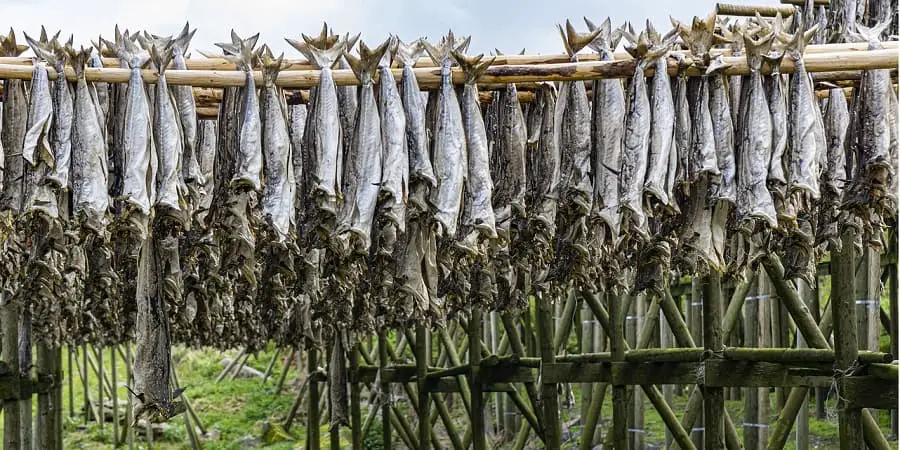Lutefisk is a traditional Norwegian dish that can be documented back to the 15th century.
It is made from dried whitefish which is then soaked in water to which lye is added. It is typically cooked in the oven before being served with bacon grease or melted butter, boiled potatoes or lefse, as well as garnish such as Mustard sauce, mashed peas, cured cheese, and lingonberry jam.
Today it is considered a traditional Norwegian Christmas dish that is served at dinner parties and restaurants throughout Norway from October to January.

What is lutefisk?
Lutefisk is a traditional Norwegian Christmas dish. It is made from dried whitefish which is then soaked in water to which lye is added. It is most common to use tried cod, but other white fish can be used as well.
After being prepared in lye, the fish obtains a jelly-like consistency, depending on the concentration of the lye. At this point, it is ready for its final preparation.
Why is lutefisk soaked in lye?
While the dish is mentioned in literature dating back to the 15th century, no one really knows why lutefisk is prepared the way it is.
Today, lye is simply added to the water once the dried cod is soaked. However, back in the day, lye was obtained from birch ash.
This has led to the theory that lutefisk was discovered after a drying rack for cod built with birch caught fire. While the townspeople tried to put out the fire with water, they were not successful, and the fish, thought to be no good, was left in the wet ash. As this turned to lye, some townspeople discovered that the fish was edible after all, and lutefisk was born.
While this is an interesting theory, it is more likely that lye, which was a common cleaning agent back in the day, was used to wash dried fish that were not of top quality so that it could be eaten and not go to waste.
How is lutefisk prepared?
Today, lutefisk is prepared from dried cod of the highest quality. First, the dried fish is soaked and put in water to soak, to which lye is later added. The concentration of lye will determine the consistency of the lutefisk.
With high concentrations of lye, the fish obtains a more jelly-like consistency, while lower concentrations will give firmer lutefisk. Once treated with lye, salt is sprinkled on top in preparation for cooking.
While it can be cooked in water, it is most common to cook lutefisk in the oven. This is especially true for lutefisk that has been prepared with high lye concentration, as it is less firm and more prone to break during handling.
How is lutefisk served?
Lutefisk is served hot straight from the oven. The garnish varies across the country, however, it is always served with some sort of fat. This can come from the preparation of other Christmas dishes (such as ribbed). However, Today, it is most commonly served with bacon along with bacon grease, however, melted butter can also be used.
Aside from this, it is usually served with boiled potatoes, but this can be replaced with potato lefse. Other garnish includes Mustard sauce, mashed peas, cured cheese, and lingonberry jam.
Where and when do you eat lutefisk?
Lutefisk is a traditional Christmas dish and it is served in restaurants throughout the country from October to January. Lye-treated lutefisk is also available in stores and it is common to have friends and family over for a lutefisk dinner.
While Norway is the birthplace and epicenter for lutefisk, it is also eaten in Sweden and parts of Finland. That being said, there is more lutefisk consumed in the United States than in Scandinavia. Also, the self-proclaimed lutefisk capital of the world is not found in Norway, but in Madison in the state of Minnesota.
This is a result of the numerous Norwegian-Americans in that region who keep the tradition alive by serving it in churches and nordic fraternal groups throughout the upper midwest during fall and winter.
Can you make lutefisk at home?
The actual process of preparing the dried cod in water in lye is best left to professionals. If you get it wrong you can end up with a potentially harmful piece of fish. Also, for the beginner, I recommend going with fish that has been prepared with less concentrated lye solutions. This makes the fish firmer and easier to handle when cooking.
If you are not able to get some lutefisk from Norway, there are a few online niche stores selling Scandinavian/Norwegian foods online. One of them is Willys’s products, which sell Scandinavian foods on its website scandinavianfoodstore.com
Final thoughts
Lutefisk is a weird dish, soaking fish in lye doesn’t sound like it will make delicious food. Some argue that lutefisk is inedible and that people only eat it because of tradition. Others find it to be a delicacy they can’t live without.
Hate it or love it, lutefisk is and will remain a Norwegian classic that every Norwegian must try at least once during their lifetime. If you happen to be in Norway during late fall or Christmas, you can have a taste yourself to get a truly Norwegian culinary experience.

